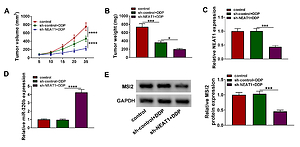Current issue
Archive
Manuscripts accepted
About the Journal
Editorial office
Editorial board
Section Editors
Abstracting and indexing
Subscription
Contact
Ethical standards and procedures
Most read articles
Instructions for authors
Article Processing Charge (APC)
Regulations of paying article processing charge (APC)
OBSTETRICS AND GYNAECOLOGY / RESEARCH PAPER
Long non-coding RNA NEAT1/miR-320b/MSI2 axis regulates cisplatin resistance in ovarian cancer
1
Department of Pharmacy, Eye, Ear, Nose and Larynx Hospital, Liaocheng People's Hospital, Liaocheng, Shandong, China., China
2
Department of Pharmacy, Eye, Ear, Nose and Larynx Hospital, Liaocheng People's Hospital, No.Dongchang West Road 252000, Liaocheng, Shandong, China., China
Submission date: 2020-01-10
Final revision date: 2020-12-10
Acceptance date: 2020-12-10
Online publication date: 2021-04-05
Corresponding author
Degang Zhou
Department of Pharmacy, Eye, Ear, Nose and Larynx Hospital, Liaocheng People's Hospital, No.Dongchang West Road 252000, Liaocheng, Shandong, China., China
Department of Pharmacy, Eye, Ear, Nose and Larynx Hospital, Liaocheng People's Hospital, No.Dongchang West Road 252000, Liaocheng, Shandong, China., China
KEYWORDS
TOPICS
ABSTRACT
Introduction:
Ovarian cancer (OC) frequently occurs in postmenopausal women and it has higher mortality rate. Accumulating researches proved that long non-coding RNA nuclear paraspeckle assembly transcript 1 (NEAT1) involved in the progression of chemoresistance in human OC. Here, the study aimed to investigate the partial molecular mechanism of OC chemoresistance.
Material and methods:
The levels of NEAT1 and microRNA-320b (miR-320b) were measured by qRT-PCR. Western blot was carried out to determine the protein levels that used in this research. Cell viability was identified via Cell Counting Kit-8 (CCK-8). Transwell assay was employed to determine migration and invasion. The relationship between miR-320b and NEAT1 or MSI2 was clarified by dual-luciferase reporter assay, RNA immunoprecipitation (RIP) and RNA pull down assay. Also, a murine xenograft assay was used to explore the effect of NEAT1 on cisplatin resistance in OC in vivo.
Results:
The level of NEAT1 was significantly increased in cisplatin resistant OC cell lines. Downregulation of NEAT1 enhanced cisplatin sensibility in OVCAR-3/DDP and HEY/DDP cells. Furthermore, miR-320b was a target of NEAT1, and the effects of knockdown of NEAT1 on the cell viability, IC50 of cisplatin, migration and invasion in OVCAR-3/DDP and HEY/DDP were restored by the inhibitor of miR-320. In addition, miR-320b directly targeted MSI2 to regulate cisplatin sensibility in cisplatin resistant OC cells. In addition, downregulation of NEAT1 decreased cisplatin resistance in OC in vivo.
Conclusions:
NEAT1 regulated cisplatin resistance through NEAT1/miR-320b/MSI2 axis in OC, which might offer a novel therapy target for the chemotherapy of OC.
Ovarian cancer (OC) frequently occurs in postmenopausal women and it has higher mortality rate. Accumulating researches proved that long non-coding RNA nuclear paraspeckle assembly transcript 1 (NEAT1) involved in the progression of chemoresistance in human OC. Here, the study aimed to investigate the partial molecular mechanism of OC chemoresistance.
Material and methods:
The levels of NEAT1 and microRNA-320b (miR-320b) were measured by qRT-PCR. Western blot was carried out to determine the protein levels that used in this research. Cell viability was identified via Cell Counting Kit-8 (CCK-8). Transwell assay was employed to determine migration and invasion. The relationship between miR-320b and NEAT1 or MSI2 was clarified by dual-luciferase reporter assay, RNA immunoprecipitation (RIP) and RNA pull down assay. Also, a murine xenograft assay was used to explore the effect of NEAT1 on cisplatin resistance in OC in vivo.
Results:
The level of NEAT1 was significantly increased in cisplatin resistant OC cell lines. Downregulation of NEAT1 enhanced cisplatin sensibility in OVCAR-3/DDP and HEY/DDP cells. Furthermore, miR-320b was a target of NEAT1, and the effects of knockdown of NEAT1 on the cell viability, IC50 of cisplatin, migration and invasion in OVCAR-3/DDP and HEY/DDP were restored by the inhibitor of miR-320. In addition, miR-320b directly targeted MSI2 to regulate cisplatin sensibility in cisplatin resistant OC cells. In addition, downregulation of NEAT1 decreased cisplatin resistance in OC in vivo.
Conclusions:
NEAT1 regulated cisplatin resistance through NEAT1/miR-320b/MSI2 axis in OC, which might offer a novel therapy target for the chemotherapy of OC.
We process personal data collected when visiting the website. The function of obtaining information about users and their behavior is carried out by voluntarily entered information in forms and saving cookies in end devices. Data, including cookies, are used to provide services, improve the user experience and to analyze the traffic in accordance with the Privacy policy. Data are also collected and processed by Google Analytics tool (more).
You can change cookies settings in your browser. Restricted use of cookies in the browser configuration may affect some functionalities of the website.
You can change cookies settings in your browser. Restricted use of cookies in the browser configuration may affect some functionalities of the website.



